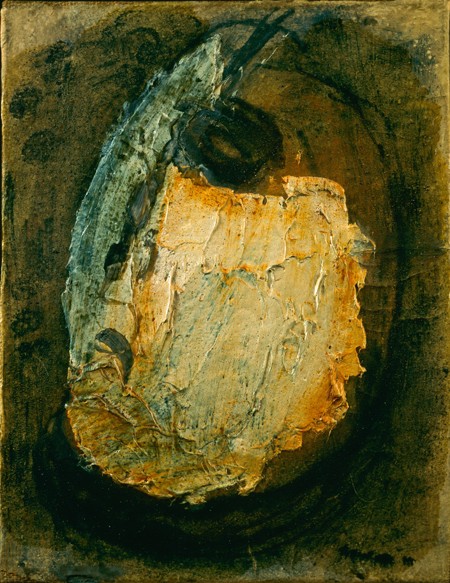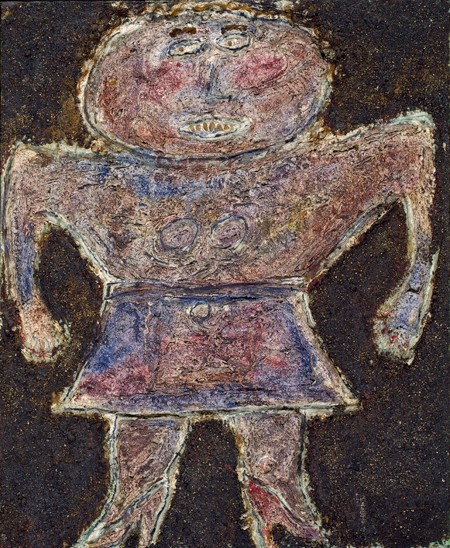During the early 1940s—as the war raged and the reality of the Nazi occupation set in—the artists Jean Dubuffet (1901–1985) and Jean Fautrier (1898–1964) were quietly at work on a kind of matter-based painting subsequently called matiérisme (
Members' Research Report Archive
Making Painting Matter: Jean Dubuffet, Jean Fautrier, and French Art in the 1940s
Rachel E. Perry, Haifa University
Ailsa Mellon Bruce Visiting Senior Fellow, September 1–October 31, 2016

Jean Fautrier, Hostage No. 7, 1944, mixed media on paper mounted on canvas. Private collection. Art Resource, NY; © Artists Rights Society (ARS), New York

Jean Dubuffet, Miss Cholera, January 1946, oil, sand, pebbles, and straw on canvas. Solomon R. Guggenheim Museum, gift, Katharine Kuh, 1972. Solomon R. Guggenheim Foundation / Art Resource, NY; © Artists Rights Society (ARS), New York
Most histories of postwar French art celebrate Fautrier as the engaged and enraged artist of Hostages, a series of forty-six paintings and three sculptures of decapitated heads and disfigured bodies created clandestinely during the Occupation. In the chapter “Matter and Memory,” I revisit the reception of the series and demonstrate that although the exhibition had everything to attract the crowds—a timely subject, a strategically important location, and the endorsement of the intelligentsia—it was a critical and commercial failure. The reputedly breakthrough exhibition received at most eight reviews, and few of the works sold, even at very low prices. Aside from a close circle of devotees, the public denounced them as inappropriate and inadequate memorials for the nation’s fallen. My research in the archives of the United States Holocaust Memorial Museum suggests that by the time Fautrier’s exhibition opened, the series was competing against atrocity photographs from the liberation of the camps, displayed in newspapers and magazines, films and posters, and sensational blockbuster exhibitions such as Crimes Hitlériens at the Grand Palais in the summer of 1945.
Dubuffet’s exhibition Mirobolus, Macadam et Cie followed Fautrier’s by six months. My chapter “Banking on Mud” examines how Dubuffet’s base materials—the macadam, gravel, and asphalt that literally underlay the rebuilding projects of the reconstruction—became a matter for speculation. Intended to antagonize French taste, Dubuffet’s gambit backfired: All of the paintings sold in a few days, and at top dollar. Dubuffet produced not only a “rehabilitation of mud” (the title of the essay he wrote for the catalog) but its transformation into gold. The paintings alluded to this virtual alchemy, featuring figures wearing jewels and precious metals (Golden Portrait, Dancing Woman with Diamond, Portrait with Medallion), which indicated the currency and value of Dubuffet’s project but also offered a biting critique of a culture of surface display and conspicuous consumption.
With titles such as Mr. Macadam, Stroller with an Umbrella, Touring Club, and Venus of the Pavement, Dubuffet’s series is uncannily preoccupied with circulation (geographic and economic) and currency (what is in mode and hard cash). And it emerged at a moment when France was engaged in an all-out public relations campaign to promote its fashion and luxury goods industries—most of which were based outside the Galerie Drouin on the Place Vendôme. The members of Dubuffet’s “company” are, like his patrons, window-shopping flaneurs parading their overinflated egos on the streets of Paris: smug businessmen; debonair socialites in snazzy bow ties; and fashionable, fully accessorized ladies-who-lunch. Like his Miss Cholera, they are quite literally the “well-heeled” of society.
Dubuffet’s dramatic entry into the art world coincided with an exponential jump in the number of galleries in the capital as the art market rebounded after the war. Addressing the commerce between materiality and materialism, between the artist’s high pastes and his public’s high taste, Dubuffet’s macadam men and asphalt ladies, flashing their wristwatches and pocket watches on shiny gold chains, arrived just in time—for speculation.
- Dubuffet, Jean
- French, 1901 - 1985
- Fautrier, Jean
- French, 1898 - 1964